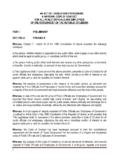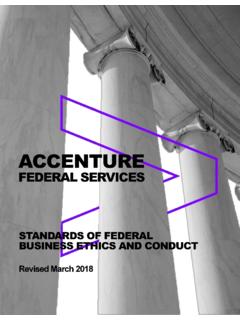Transcription of Tobacco industry interference with tobacco control …
1 Tobacco industry interferencewith Tobacco control World Health Organization 2008 All rights reserved. Publications of the World Health Organization can be obtained fromWHO Press, World Health Organization, 20 Avenue Appia, 1211 Geneva 27, Switzerland(tel.: +41 22 791 3264; fax: +41 22 791 4857; e-mail: Requests forpermission to reproduce or translate WHO publications whether for sale or for noncommercialdistribution should be addressed to WHO Press, at the above address (fax: +41 22 791 4806;e-mail: designations employed and the presentation of the material in this publication do not implythe expression of any opinion whatsoever on the part of the World Health Organizationconcerning the legal status of any country, territory, city or area or of its authorities, or concerningthe delimitation of its frontiers or boundaries. Dotted lines on maps represent approximate borderlines for which there may not yet be full mention of specific companies or of certain manufacturers products does not imply thatthey are endorsed or recommended by the World Health Organization in preference to others ofa similar nature that are not mentioned.))
2 Errors and omissions excepted, the names of proprietaryproducts are distinguished by initial capital reasonable precautions have been taken by the World Health Organization to verify theinformation contained in this publication. However, the published material is being distributedwithout warranty of any kind, either expressed or implied. The responsibility for theinterpretation and use of the material lies with the reader. In no event shall the World HealthOrganization be liable for damages arising from its Library Cataloguing-in-Publication DataTobacco industry interference with Tobacco industry - legislation. industry - trends. - prevention andcontrol. - economics. - supply and distribution. Health Organization. Tobacco Free Initiative. of theParties to the WHO Framework Convention on Tobacco 978 924 159734 0 (NLM classification: HD )TABLE OF CONTENTSPREFACEvPart industry efforts to thwart effective tobaccocontrol1 MONITORING OF THE Tobacco industry BY WHO1 WHO COMMITTEE OF EXPERTS ON Tobacco industry DOCUMENTS2 WORLD HEALTH ASSEMBLY RESOLUTION : TRANSPARENCY IN Tobacco CONTROL2AD HOC INTER-AGENCY TASK FORCE ON Tobacco CONTROL3 WHO FRAMEWORK CONVENTION ON Tobacco CONTROL3 SCOPE OF Tobacco industry INTERFERENCE4 THE Tobacco industry AND ITS ALLIES5 THE SUPPLY AND SALE CHAIN7 ALLIES, THIRD PARTIES AND FRONT GROUPS8 FUNDING OF SCIENTISTS AND RESEARCHERS10 STRATEGIES USED BY THE Tobacco INDUSTRY12 EDUCATION13 ENVIRONMENT14 lobbying AND POLITICAL CAMPAIGN CONTRIBUTIONS15 CORPORATE SOCIAL RESPONSIBILITY MOVEMENT AND PHILANTHROPY15 ECONOMIC ARGUMENTS17 Part II.
3 Monitoring Tobacco industry efforts to thwarttobacco control19 GAPS IN RESEARCH20 MODELS FOR MONITORING Tobacco industry ACTIVITIES20 AMERICAN STOP SMOKING INTERVENTION STUDY (USA)20 NATIONAL HEALTH SURVEILLANCE AGENCY (BRAZIL)21 Tobacco REPORTING REGULATIONS (CANADA)21 control AND TRANSPARENCY WHEN MEETING THE Tobacco industry AND ITSREPRESENTATIVES AND ALLIES21 Concluding remarks22 Acknowledgements23 References25 Appendix 1. ASSIST concept map of Tobacco industry tactics toundermine Tobacco controliii36 PREFACEA large body of evidence demonstrates that Tobacco companies use a wide range of tactics tointerfere with Tobacco control . Such strategies include direct and indirect political lobbying andcampaign contributions, financing of research, attempting to affect the course of regulatory andpolicy machinery and engaging in social responsibility initiatives as part of public more and more is known about Tobacco industry tactics, a systematic, comprehensiveguide is needed to assist regulators and policy-makers in combating those practices.
4 Guidelinesand recommendations exist for countering and monitoring industry marketing, andrecommendations have been issued to refuse industry funding of certain activities, but no broadpolicy has been published to assist government officials, policy- makers and nongovernmentalorganizations in their interactions with the Tobacco WHO Tobacco Free Initiative (TFI), the department in WHO with the mandate to control theglobal Tobacco epidemic, monitors the activities of the Tobacco industry in accordance with WorldHealth Assembly resolution , which urges Member States to be aware of affiliations betweenthe Tobacco industry and members of their delegations, and urges WHO and Member States tobe alert to any efforts by the Tobacco industry to continue its subversive practice and to assurethe integrity of health policy development in any WHO meeting and in national a continuing response to this mandate, TFI convened a group of experts to discuss tobaccoindustry interference in Tobacco control and the public health policies and initiatives of WHOand its Member States.
5 The meeting took place at the offices of the Pan American HealthOrganization (PAHO) in Washington DC, United States of America, on 29 30 October the meeting, participants received a background paper commissioned by TFI, which servedas the basis for discussions. The experts were asked to draw up a list of topics and concepts thatshould be included in policies to counter attempts by the Tobacco industry to interfere withtobacco control . The list facilitated discussions on gaps in scientific evidence and the challengeof finding means for countering the wide range of types of interference ( political, economicand scientific). This list also provided examples of proactive ways of eliminating tobaccocompanies influence, including: policies refusing partnerships with Tobacco companies; policiesrefusing Tobacco company funding of research and programmes; rejecting self-regulatory orvoluntary policies in Tobacco control ; encouraging divestment from Tobacco investments; andpromoting social indexing that excludes Tobacco and businesses models that can be used tocounter industry meeting participants agreed that the results of the discussions should be incorporated into adocument, to broaden understanding in the global public health community of the tobaccoindustry s influence on Tobacco control .
6 This document is therefore a synthesis of the evidence-based discussions, revisions and suggestions of the experts and is presented in a format that canreadily be used by policy-makers and is based on the best available evidence on Tobacco industryattempts to interfere with Tobacco control and public document begins by stating that effective Tobacco control and the commercial success of thetobacco industry are fundamentally incompatible and that, accordingly, the Tobacco industry canbe expected to seek to avoid, prevent, weaken and delay effective policies and programmes, whichare against its interests. Equally, Tobacco control , in seeking to maximize the decline in Tobacco -related disease and in the Tobacco use that causes such disease, must be vigilant in monitoringPrefacevthe wide range of Tobacco industry actions to undermine effective Tobacco control . Part I describesthe means used by the Tobacco industry and its allies to thwart effective Tobacco control andsummarizes the industry s history of undermining Tobacco control , through direct lobbying andthe use of third parties, academics and researchers.
7 Part II describes the means used to monitorindustry efforts to interfere with Tobacco aims for this document to provide the Contracting Parties to the WHO FCTC, and otherWHO Member States, background and contextual information that may assist with theimplementation of the WHO FCTC Article Guidelines which were adopted at the third sessionof Conference of Parties (COP) in Durban, South Africa in November 2008 to counter tobaccoindustry interference with Tobacco industry EFFORTS TOTHWART EFFECTIVE TOBACCOCONTROLE ffective Tobacco control is, almost by definition, antithetical to the economic interests of thetobacco industry , associated industries, and entities or persons working to further the tobaccoindustry s agenda. Those interests depend largely on the prosperity of the Tobacco industry andits means for ensuring its real or perceived commercial well-being. The primary goal of tobaccocontrol is to prevent Tobacco -caused disease and death.
8 In the hierarchy of objectives for reachingthis goal, preventing the uptake of Tobacco use and assisting Tobacco users in ceasing use of allforms of Tobacco rank highest. Similarly, efforts designed to reduce exposure to second-handsmoke are most effective when smoking is prohibited in public triumvirate of objectives preventing uptake, maximizing cessation and prohibitingsmoking in public places stands in direct opposition to the commercial objectives of the tobaccoindustry. Although the industry sometimes makes expedient public statements to the contrary,it routinely seeks to maximize uptake of Tobacco use, do all that is possible to ensure that tobaccousers continue to be consumers and prevent the erosion of smoking opportunities by restrictionsknown to reduce smoking frequency (1) and promote cessation (2). Thus, when Tobacco controlsucceeds, the Tobacco industry fails. People employed by the Tobacco industry have fiduciaryresponsibilities to their shareholders or government owners to take all legal steps possible tomaximize profits.
9 It is therefore entirely predictable that the Tobacco industry does what it can toensure that effective Tobacco control policies an analogy with the classic public health model of communicable disease control , the tobaccoindustry has been described as the principal vector of Tobacco -caused disease (3). Like efforts tounderstand the chain of transmission and death in communicable diseases, comprehensivetobacco control requires that public health authorities monitor and counteract the efforts of thetobacco industry to promote Tobacco use and to undermine Tobacco Gro Harlem Brundtland, former Director-General of the WHO, described Tobacco use as acommunicated disease communicated through marketing (4). The promotional activities of theindustry are directly responsible for the spread of Tobacco use, especially among young peopleand women and in developing countries, who are the latest targets of Tobacco industry , countering and eliminating their activities will decrease the disease burden oftobacco of the Tobacco industry by WHOWHO is well aware of the long history and the extent of Tobacco industry efforts to avoid, delayand dilute the advancement of effective Tobacco control policies and interventions.
10 The positionof WHO is that it will not accept funding from the Tobacco industry (5). Understanding andeffectively counteracting efforts by the Tobacco industry and its allies to oppose Tobacco controlare crucial. Given this reality, the WHO Tobacco Free Initiative (TFI) monitors and draws globalattention to the activities and practices of the Tobacco industry (6).Part I. Tobacco industry efforts to thwart effective Tobacco control1 WHO committee of experts on Tobacco industry documentsIn 2000, the WHO committee of experts on Tobacco industry documents published Tobaccoindustry strategies to undermine Tobacco control activities at the World Health Organization (7). Thisreport summarizes evidence obtained from internal Tobacco industry documents of actions takento influence and undermine WHO Tobacco control policies and programmes. The committeefound that the industry used a range of strategies to weaken or prevent advances in tobaccocontrol, including: establishing inappropriate relationships with WHO staff; wielding financial power; leveraging influence through other United Nations agencies; discrediting WHO or WHO officials; using surrogates, such as front groups and trade unions; distorting WHO research; staging media events to distract from Tobacco control initiatives; and monitoring and surveying WHO committee found that the evidence shows that Tobacco companies have operated for manyyears with the deliberate purpose of subverting the efforts of WHO to address Tobacco issues.














